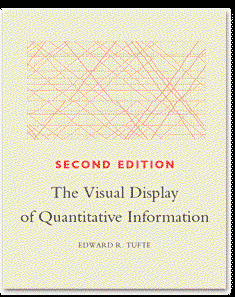Tufte's Books
Edward Tufte’s books are probably the most famous (or infamous) books on visualization. They are more art history books, full of historical examples and commentary, then books to help you understand or design visualizations. However, they are very influential, and everyone in the field (and many people outside of the field) talk about them. We’ll look at parts for class.

Tufte is an important character in the story of visualization. He asserts his strong opinions as fact, even though they are often just his personal taste, examples of bad reasoning, not supported by evidence, or flat out wrong. You can read my discussion of this from the 2015 class. We’ll also read some counterpoint to him, so you’ll be able to appreciate it. Cairo’s The Functional Art has a nicely balanced discussion of Tufte, which we’ll read. We’ll also look at a critique of his critique style by Wattenberg and Viegas.
Despite their flaws, or maybe because of their flaws, Tufte’s books are really important. They are an important part of the dialog around visualization: everyone who works in the field is familiar with them.
Unfortunately, the library does not provide these books online. We will provide you with some chapters, but you might want to buy your own copy so you can see more of the book.
We will provide a limited number of chapters of this book to you under academic fair use. These chapters will be provided in Canvas. Please do not share them outside of class as academic fair use is only for required class use. Because of the limitations of academic fair use, we can only provide a portion of the book.
You can buy the complete set of four books from him directly. He used to offer a reduced price for students. They are nicely designed books, full of interesting examples. Tufte’s opinionated (and not always well thought out, as we will see) arguments need to be taken in context.